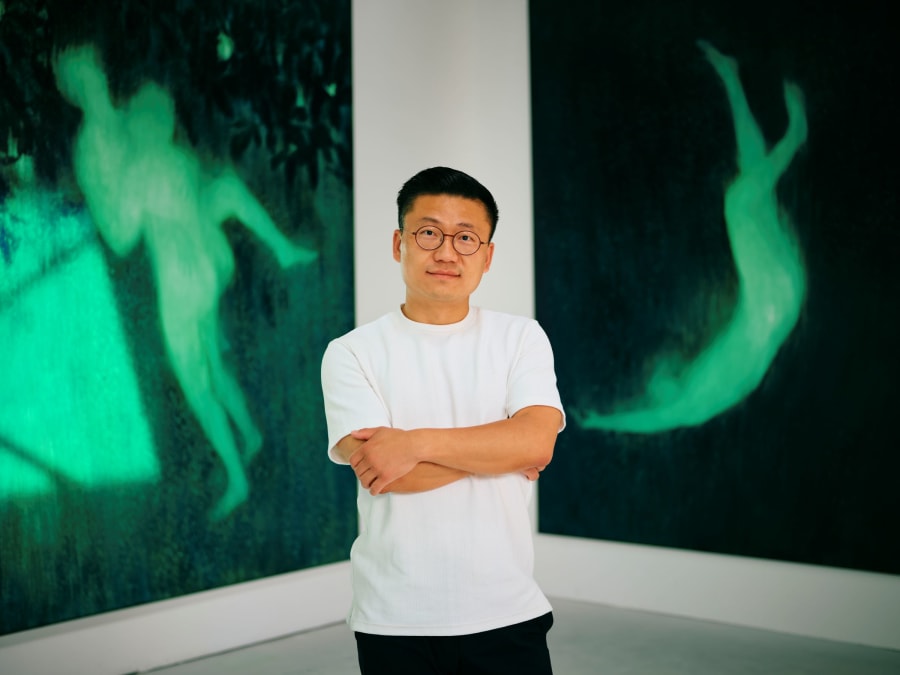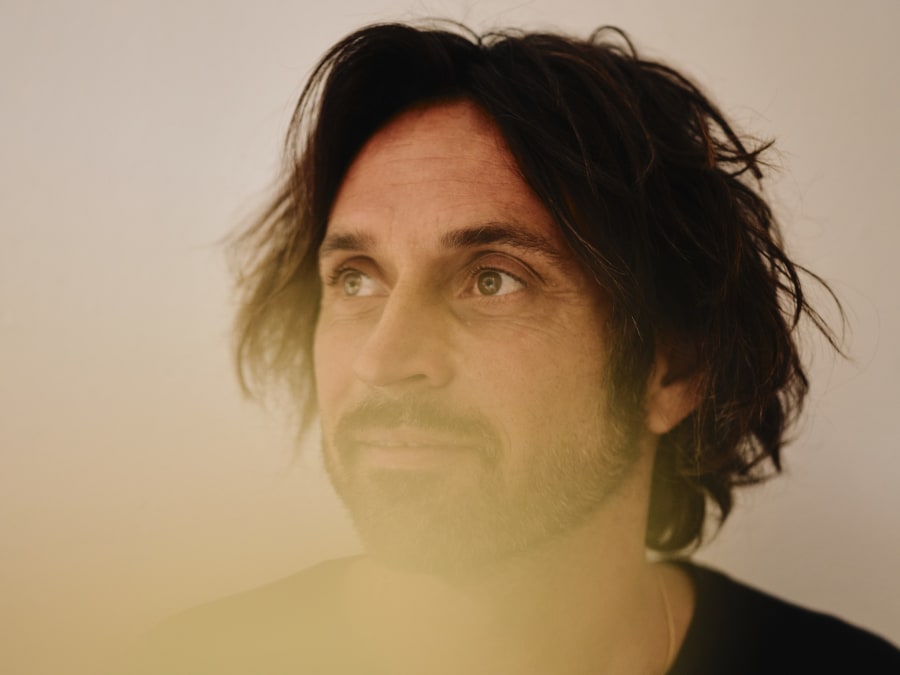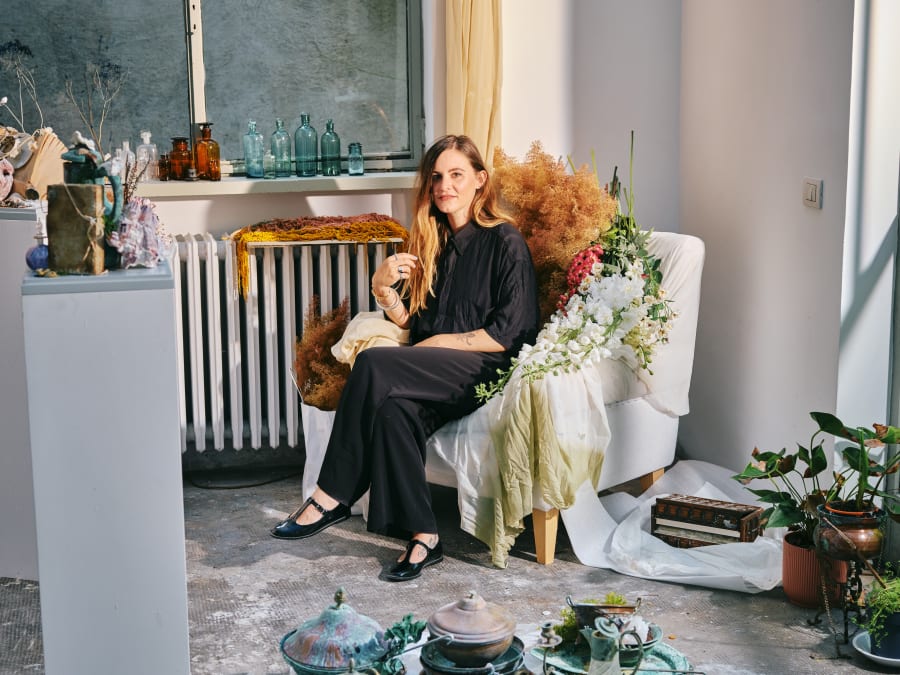In collaboration with the Centre Pompidou
Last year, a scientific study of the Mediterranean basin revealed a troubling truth: by 2100, a quarter of the Camargue in France will be under water due to climate change. The effects are already visible in this region shaped by the Rhône delta and known for its rose-tinted salt marshes, where 25% of the land lies below sea level. This evolving area first caught the attention of Eva Nielsen a few years ago, as she prepared a project for the BMW Art Makers program. For the past three years, it has never left the mind of the French artist, nominated this year for the Prix Marcel Duchamp. Fascinated by its erosion and alarmed by its predicted disappearance, the artist has been exploring the Camargue through works that combine photography and painting. A first grouping was unveiled at the Rencontres d’Arles in summer 2023. In these pieces, a play on transparency and layering extends the formal principles she had already begun to develop in her enigmatic, hybrid landscapes of floating architectures against twilight skies – compositions on canvas she has been creating since the late 2000s.
Nielsen now freely admits that when she set out on her artistic path 20 years ago, first turned to analog photography as a way of capturing the landscapes she observed from the windows of the RER: former rural areas that had been rapidly urbanized since her birth in the early 1980s. As a teenager, armed with her camera, she roamed the construction sites and abandoned buildings of the outskirts of a burgeoning ‘Grand Paris’ – committing them to film. ‘What I loved about analog photography was its retinal persistence, the shot/reverse shot, the alchemy,’ she recalls. ‘But above all, I loved the idea of making something appear.’
Her fascination with printing techniques led to a discovery during her studies at the École des Beaux-Arts in Paris that would prove decisive: screen printing. ‘I realized very early on that my practice needed to be hybrid, like the spaces I’d been moving through since childhood. Screen printing immediately felt like the obvious choice: It was the perfect combination of painting and photography. ‘In the school’s dedicated workshop, alongside fellow student Raphaël Barontini, Nielsen embraced the technique in an experimental way. First, on Photoshop, she created collages from her own photographs, layering images to ‘stratify [her] gaze and recompose it on the canvas through screen printing.’ Then, sometimes using large formats, she built up black-and-white architectural forms, stencil by stencil, which she later masked with tape, in order to paint the untouched areas in oil. Her most emblematic works bear this signature composition: in the foreground, a grayscale architectural fragment – brutalist structure, spiral staircase, gate or railing – set against a colored landscape, the horizon line and sky painted from her photographs.
‘I try to suggest volume, to sculpt the negative space, but in two dimensions,’ Nielsen explains in her studio in Paris’s 13th arrondissement. Inspired by sculptors Robert Rauschenberg and Barbara Hepworth as well as painter Georgia O’Keeffe, she emphasizes her attraction to the materiality the medium affords. ‘Screen printing preserves the painting’s graininess. The slides we burn also act as a screen, a sieve.’ For nearly 15 years she worked in a highly artisanal way, exposing screens with garden lamps, before recently acquiring a professional machine.
Nielsen reminds us that screen printing is a physical practice, one that engages the whole body – just like when she paints, often with the canvas spread on the floor. ‘At a certain point, I can’t tell where my studio floor ends and my painting or my legs begin. It’s as if I’m wading through my own work,’ she laughs, likening her workspace to the marshes that inspire her. On her canvases – ranging from small formats to some that are two or three meters high and wide – she doesn’t hesitate to leave imperfections visible. ‘Even though I prepare my compositions with great care, gaps remain. The edges between screens, the differences in inking…These create texture, nuance, and a striking strangeness that, for me, resonates with human experience.’
From the Vercors mountains south of Grenoble to Iceland’s volcanoes, Nielsen loves to travel and photograph nature as she finds it. Yet the works that emerge from these images are far from topographical. Instead, they draw us into indeterminate landscapes whose components resist localization. ‘We’re always on the edge of the city and at the limits of the visible, in a zone of uncertainty,’ she sums up. These enigmatic, almost dreamlike spaces may evoke M. C. Escher’s impossible architectures, Giorgio de Chirico’s metaphysical vistas, or the lost horizons painted by Kay Sage. But Nielsen’s use of photography and screen printing lends them a destabilizing, unsettling realism, even a trompe-l’œil effect. In recent years, she has discreetly introduced the human figure, using photos from her family archive printed on silk organza or latex stretched across the painted canvas. The superimposed fabric produces textural effects, vibrations, and transparency that give these figures a spectral aura, echoing the artist’s central obsessions of ‘seeing through’ and ‘bringing to the surface.’
For the 25th edition of the Prix Marcel Duchamp, presented for the first time at the Musée d’Art Moderne de Paris, Nielsen unveils Rift – a geological term describing the rupture that leads to the research: beyond the two large-scale canvases, she conveys the idea of ‘sedimentation,’ of layers and depth, using metal structures to suspend smaller works that ‘appear like echoes, like resurfacing memories.’
Parts of these new works were created during her recent return to the Camargue, where she pushed the fusion between image and nature further. ‘In front of these salt marshes, I truly felt as though I were standing in front of photographic baths in the darkroom.’ To bring this analogy to life, she took her prints with her and immersed them in the marshes, letting them float in the water and emerge marked by natural deposits. The work imprints the landscape, the landscape imprints the work…and, while revealing its extraordinary character, it alerts viewers to the urgency of preserving this area.
This article is part of a collaboration with the Centre Pompidou for the Prix Marcel Duchamp 2025. View it here on the Centre Pompidou website.
Eva Nielsen is represented by Galerie Peter Kilchmann (Paris, Zurich) and The Pill (Paris, Istanbul).
Prix Marcel Duchamp
Musée d’Art Moderne de Paris
From September 26, 2025, to February 22, 2026
Matthieu Jacquet is a journalist based in Paris.
English translation: Art Basel.
Caption for header image: Eva Nielsen photographed by Guillaume Blot for Art Basel and Centre Pompidou.
Published on September 18, 2025.


